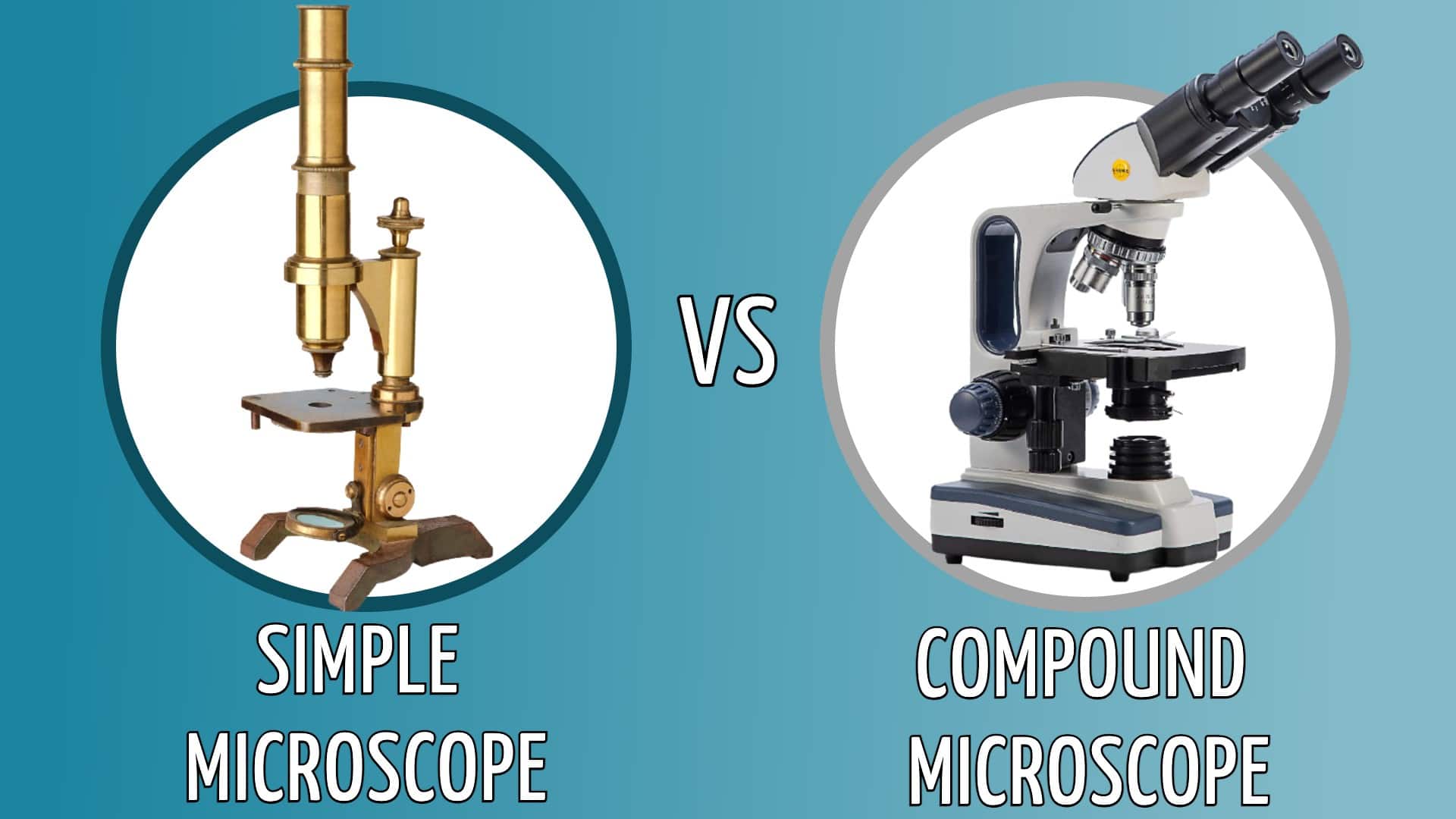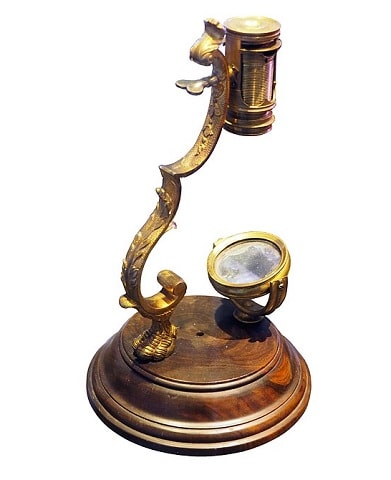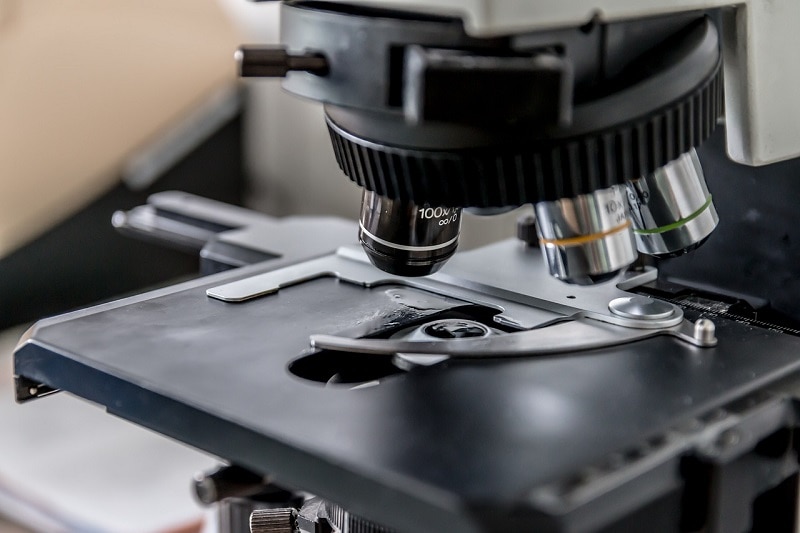Simple vs. Compound Microscope: What’s the Difference?
Last Updated on

When the microscope burst its way onto the scene, it revolutionized how humans looked at the world around them. While advances to microscopes continue to this day, it was the humble beginnings of the simple microscope that started it all.
From there, the compound microscope took things to the next level, but that doesn’t mean that the simple microscope is totally irrelevant.
In this comprehensive guide, we’ll break down everything you need to know about both types of microscopes and help you identify where you can find both types of microscopes.

Overview of Simple Microscopes
Simple microscopes aren’t a new invention, but they hold even more importance today than the day that they were invented. We’ll break down everything you need to know about these marvels below.

A Brief History
You can find references of simple microscopes mentioned all the way back to the 13th century when people used them predominantly in eyeglasses. But there’s little doubt that simple microscopes were used long before that.
In fact, the Nimrud lens, the earliest known device found that scientists think might’ve been used as a simple microscope, dates to 700 BCE – and was found in modern-day Iraq. Moreover, the Chinese utilized water microscopes as early as 167 BCE.
There’s no doubt that humans have been magnifying objects with simple microscopes for thousands of years – but what does a simple microscope consist of – and how does it work?
How It Works
Simple microscopes consist of one convex lens that changes how the light passes through it to make an object appear larger than it actually is. Convex refers to the shape of the lens and curves outwards – just like your eye.
This convex shape makes the image appear larger, but it can also distort the image, especially around the edges.
Where You’ll Find Simple Microscopes
Simple microscopes are all around us, and they’re incredibly useful. The most common simple microscope you’re likely to notice is eyeglasses. However, you can easily find a pocket magnifying glass that utilizes a simple microscope design too!
- Utilizes natural light sources
- Simple design cost less to make
- Works great for eyeglasses
- You can’t adjust magnification levels
- Lower maximum magnification

Overview of Compound Microscope
While one lens makes an image look larger – when you add more lenses, you get even better results. The tradeoff is that you get a bulkier design, but this is really only an issue with specific applications like eyeglasses. Below we’ve highlighted everything you need to know about the compound microscope.

A Brief History
While humans have been using a single lens to enlarge objects for thousands of years, it took them until the early 1590s to combine two lenses to make these images even larger.
While it might seem like that’s an excessive amount of time, it has to do with the lenses’ manufacturing process that led to these innovations. Once it became cheaper and more affordable to produce lenses, it didn’t take humans long to discover what would happen when they put two of them together.
While it took a while to get to the modern compound microscope, it didn’t take long for humans to build upon the original designs and transform them into the complex machines that exist today.
How It Works
Compound microscopes consist of multiple lenses that are spaced apart from each other to magnify images further. Basic compound microscopes consist of two lenses, a concave lens and a flat lens. However, more advanced complex microscopes can use far more lenses to magnify images further.
In this way, compound microscopes can increase magnification by adding more lenses. Moreover, they can change magnification by changing the distance between the two lenses.
Where You’ll Find Compound Microscopes
Compound microscopes are found all over the place today. Optics, laboratories, and even the reaches of space have compound microscopes. The Hubble telescope uses one, and so will Hubble’s successor, the James Webb Space Telescope.
- Higher magnification levels
- You can change the magnification levels
- More complex design makes them larger and bulkier

The Difference Between Simple and Compound Microscopes
While there are plenty of differences between a simple and a compound microscope, we decided to highlight a few of the more significant options below. While we could’ve added more information to this chart, it wouldn’t have been accurate all the time.

For instance, many compound microscopes utilize an illuminator to light up the object they’re looking at – but that’s only highlighting one type of compound microscope. A compound microscope like a telescope doesn’t utilize an illuminator but meets the criteria for a compound microscope.
Characteristics |
Simple Microscope |
Compound Microscope |
| Number of lenses | One | Two or more |
| Magnification Power | More limited (1x to 300x) | Far more powerful (1x to 5,000x+) |
| Adjustable Magnification? | No | Yes |
| Condenser Lens | No | Yes |

In Conclusion
Both the simple and compound microscopes have profound applications that have revolutionized how we look at the world around us. Hopefully, this guide broke down everything you need to know about the two designs and how they work.
Because when you understand the science behind these marvels, you can make better use of them in your optics. While advances continue to these revolutionary designs, neither of the microscopes are going anywhere any time soon!
Check out some of our top trending comparisons:
- LPVO vs. Red Dot Sights: Which Is Better?
- Red Dot vs Magnified Scope for AR 15: What’s Best?
- How to Measure Scope Ring Height
Featured Image Credit | Left: Anna Kucherova, Shutterstock; Right: Amazon
About the Author Robert Sparks
Robert’s obsession with all things optical started early in life, when his optician father would bring home prototypes for Robert to play with. Nowadays, Robert is dedicated to helping others find the right optics for their needs. His hobbies include astronomy, astrophysics, and model building. Originally from Newark, NJ, he resides in Santa Fe, New Mexico, where the nighttime skies are filled with glittering stars.
Related Articles:
How to Clean a Refractor Telescope: Step-by-Step Guide
How to Clean a Telescope Eyepiece: Step-by-Step Guide
How to Clean a Rifle Scope: 8 Expert Tips
Monocular vs Telescope: Differences Explained (With Pictures)
What Is a Monocular Used For? 8 Common Functions
How to Clean a Telescope Mirror: 8 Expert Tips
Brightfield vs Phase Contrast Microscopy: The Differences Explained
SkyCamHD Drone Review: Pros, Cons, FAQ, & Verdict
